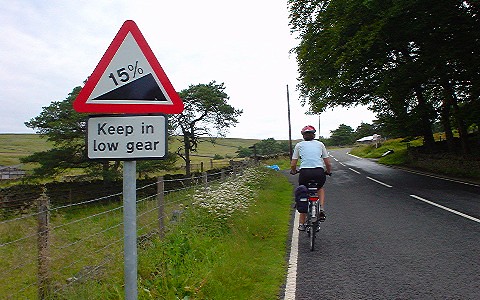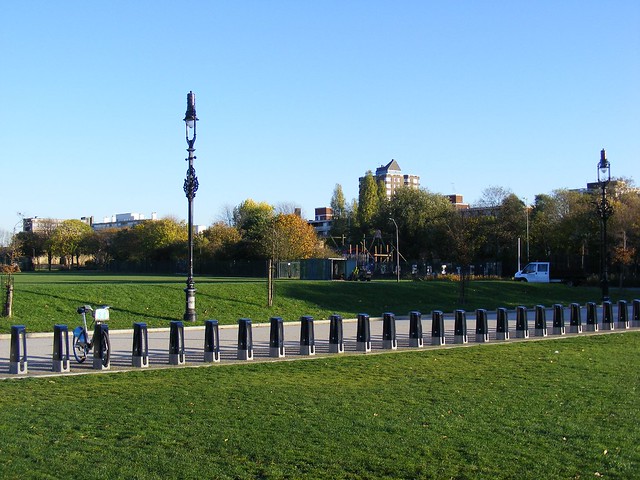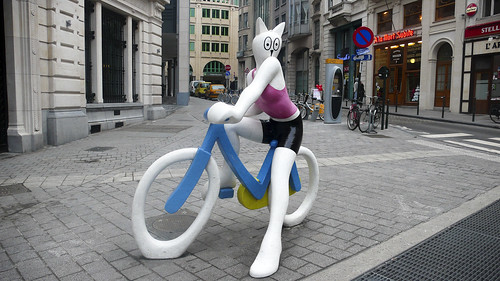
Following on from my previous post – another reason I was particularly pleased to be in Vienna for State of the Map EU, was that Vienna has a bike share system! CityBikes has been around since 2003, it is run by JC Decaux, a commercial operator, but the scheme’s running data is controlled by the city authorities, hence I’m able to include on my Bike Share Map. Obviously I had to have a go, particularly as the scheme is open to tourists with a credit card, and is only 1 euro for as many journeys as you need over 24 hours ever – as long as each journey is less than an hour.
Vienna’s scheme is quite a bit smaller than London’s – it’s spread over a similarly sized area, but the density of stations is much lower (around 20% of London’s), so some advance planning is needed – you don’t generally just come across a stand. Redistribution also seems to be less frequent – for example my local stand remained nearly empty through for the course of the entire trip. Nonetheless I was able to make all three planned trips on the CityBikes, a 100% success rate which London’s disconnected docks and failing keys can’t match.
 On the Thursday evening that we arrived, Steve and I borrowed a couple of bikes from a stand right outside the U-Bahn station on the Nachtmarkt and used them to get to the pre-conference drinks which were a couple of miles away to the north. Sign-up took ages – requiring numerous button presses and a password to be entered three times. The paper map in the stand dispenser proved to be quite handy though. We eventually got onto the fantastic, dedicated cycleways which are sensibly built on the pavements rather than the roads in Vienna, and clearly and regularly marked with blue and white cycle roundels on the ground, where errant pedestrians are more likely to look. Vienna’s streets are generally wider than London’s, allowing for such facilities – plus the narrower ones are generally one-way for cars and two-way for bikes. We accidentally headed straight into the old town rather than along the outer ring-road, but then joined the inner ring-road and had a spectacular cycle past the Museum Quarter, Parliament and City Hall. Another missed turn meant we ended up cycling three sides of a square, but we made it eventually and docked with no problems. Our return was similarly indirect – the first stand was empty, then after getting the bikes, we took an unscheduled right turn and discovered that Vienna does in fact have hills. Steve’s bike also proved to be less than road worthy, with the chain slipping and the back wheel wobbling and threatening to come off…
On the Thursday evening that we arrived, Steve and I borrowed a couple of bikes from a stand right outside the U-Bahn station on the Nachtmarkt and used them to get to the pre-conference drinks which were a couple of miles away to the north. Sign-up took ages – requiring numerous button presses and a password to be entered three times. The paper map in the stand dispenser proved to be quite handy though. We eventually got onto the fantastic, dedicated cycleways which are sensibly built on the pavements rather than the roads in Vienna, and clearly and regularly marked with blue and white cycle roundels on the ground, where errant pedestrians are more likely to look. Vienna’s streets are generally wider than London’s, allowing for such facilities – plus the narrower ones are generally one-way for cars and two-way for bikes. We accidentally headed straight into the old town rather than along the outer ring-road, but then joined the inner ring-road and had a spectacular cycle past the Museum Quarter, Parliament and City Hall. Another missed turn meant we ended up cycling three sides of a square, but we made it eventually and docked with no problems. Our return was similarly indirect – the first stand was empty, then after getting the bikes, we took an unscheduled right turn and discovered that Vienna does in fact have hills. Steve’s bike also proved to be less than road worthy, with the chain slipping and the back wheel wobbling and threatening to come off…
It turns out that there are two generations of bikes currently in use in the system. The newer ones are noticeable in that they have three gears rather than none – geared higher than London’s scheme, allowing some decent speed to be gained. They also have more comfortable handlebars, rotary bells, differently profiled rear lights and strobe front lights. The frame is also slightly different, with a lower support to the back wheel. The gears alone mean there is a considerable advantage in getting one of the new ones. In the photo at the top, the bike on the left and the furthest one on the right are the new generation bikes, while the other four are older. There are also at least four liveries on the bikes across both generations – grey/red, blue, yellow and purple.
The bikes feel heavier than London’s (if that were possible!) and because of the low dip in the middle of the frame, they tend to want to fall over a lot when you stop to look at a map and stand up. Thankfully this is OK as, in Vienna, you are generally on the cycle paths on the pavements, and not the roads themselves.
“Hot docking” – cycling straight into the dock point (a favourite of London commuters) – is just about possible, but more difficult to do than London’s – you need to approach from the left side and line up confidently. Nevertheless we had a go.
 Our final trip was more ambitious – four of us OSMers headed right through the old city, past the cathedral, and eventually into the more commercial part of the city, then underneath the huge Praterstern station and right up to the Danube. Here, there is a dedicated cycle track underneath the road bridge. The bridge is however quite a way beyond the area of docking stations, so the other cyclists around were on more serious bikes.
Our final trip was more ambitious – four of us OSMers headed right through the old city, past the cathedral, and eventually into the more commercial part of the city, then underneath the huge Praterstern station and right up to the Danube. Here, there is a dedicated cycle track underneath the road bridge. The bridge is however quite a way beyond the area of docking stations, so the other cyclists around were on more serious bikes.
It took us quite a way to get out here – over an hour, but that only resulted in an extra 1 euro charge. On the way back, it started raining as we passed under Praterstern, luckily this was as we passed a large dock, so we finished our return on the U-Bahn.












 I was in Berlin last weekend for Wherecamp EU – the European
I was in Berlin last weekend for Wherecamp EU – the European  There were some very interesting sessions – I particularly enjoyed
There were some very interesting sessions – I particularly enjoyed 







